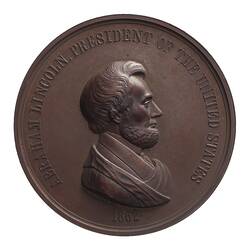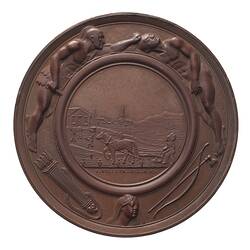Summary
Peace Medal, American Indian, issued by President Abraham Lincoln, United States of America, 1862. Peace medals played a significant role in relations between the United States government and the population Indigenous to North America (the terms Native American and American Indian are also used by government and cultural institutions in the USA).
Following the British and French practice of handing out silver medals to tribal chiefs, George Washington began a policy of presenting peace medals to American Indian leaders at treaty signings and other formal ceremonies. Every subsequent American president from Thomas Jefferson to Benjamin Harrison is represented on an American Indian peace medal, with the exception of William Henry Harrison. The medals were often produced in different sizes according to the rank of the recipients.
This example is a bronze replica created by the Philadelphia federal mint using the original dies. The series began in 1842 with the Thomas Jefferson medal.
Obverse Description
A draped bust of the President facing right; around, ABRAHAM LINCOLN PRESIDENT OF THE UNITED STATES 1862.
Reverse Description
At the centre within a circle, a village scene including children playing in front of a school and a church steeple; in the foreground an American Indian wearing full chief's feathered head-dress operates a horse-drawn plough; around above around above an Indian pulls the hair of another Indian preparing to scalp him with a knife; around below, a quiver of arrows, an Indian woman's head with eyes closed and a crossed bow and peace pipe
Edge Description
The edge is plain
More Information
-
Collecting Areas
-
Acquisition Information
Transfer from National Gallery of Victoria (NGV), United States of America: Government
-
Date Issued
1862 AD
-
Issued By
-
Person Depicted
President Abraham Lincoln - United States Government, United States of America, 1862
-
Material
Copper
-
Axis
12
-
Classification
-
Category
-
Discipline
-
Type of item
-
Dimensions
63 mm (Outside Diameter)
-
Shape
Round
-
Keywords
Indian Peace Medals, Peace, Native Americans, Indigenous Peoples, Indigenous Issues


